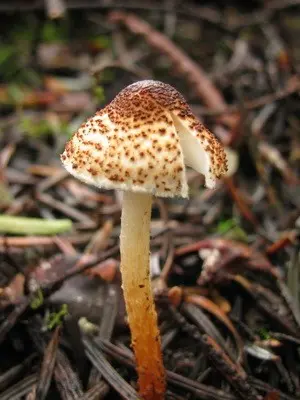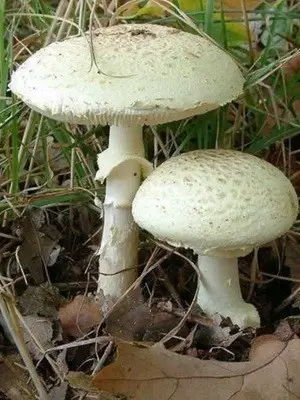Contents
For the first time, they learned about the lepiot comb in 1788 from the descriptions of the English scientist, naturalist James Bolton. He identified it as Agaricus cristatus. Lepiota comb in modern encyclopedias is classified as a fruiting body of the Champignon family, the genus Comb.
What do comb lepiotas look like
Lepiota has other names. The people call it an umbrella, as it is very similar to umbrella mushrooms, or silverfish. The last name appeared because of the plates on the hat, similar to scales.
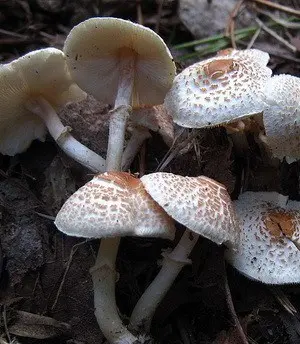
Cap Description
This is a small mushroom 4-8 cm high. The cap is 3-5 cm in diameter. It is white, in young mushrooms it is convex, resembling a dome. Then the hat takes the form of an umbrella, becomes concave-flat. In the middle is a brown tubercle, from which brownish-white scales diverge in the form of a scallop. Therefore, they call lepiota comb. The flesh is white, it crumbles easily, while the edges become pinkish-red.
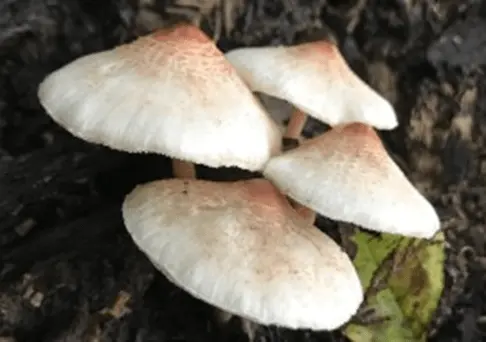
Description of the leg
The leg grows up to 8 cm. The thickness reaches up to 8 mm. It has the shape of a hollow white cylinder, often pinkish in color. Towards the base, the leg thickens slightly. Like all umbrellas, there is a ring on the stem, but this disappears with maturity.
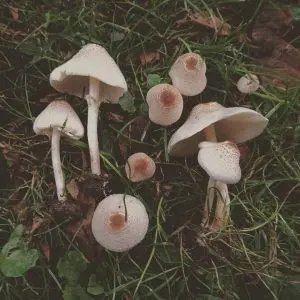
Where do combed lepiotas grow
Lepiota comb is one of the most common species. It grows in the Northern Hemisphere, namely, in its temperate latitudes: in mixed and broad-leaved forests, in meadows, even in vegetable gardens. Often found in North America, Europe, Our Country. Grows from June to September. It reproduces by small whitish spores.
Is it possible to eat comb lepiotas
Comb umbrellas are inedible lepiots. This is also evidenced by the unpleasant smell that comes from them and resembles something of rotten garlic. Some scientists believe that they are poisonous and cause poisoning when ingested.
Similarity to other species
Lepiota comb is very similar to these mushrooms:
- Lepiota chestnut. Unlike comb, it has red scales, and then chestnut color. With maturation, they appear on the leg.

- white grebe causes poisoning, often resulting in death. Mushroom pickers should be deterred by the unpleasant smell of bleach.

- Lepiota whitewhich also causes poisoning. It is slightly larger than a comb umbrella: the size of the cap reaches 13 cm, the leg grows up to 12 cm. The scales are rare, but also have a brown tint. Below the ring, the leg is darker.

Symptoms of mushroom poisoning
Knowing the poisonous types of fruiting bodies, it will be easier to identify edible mushrooms, among which there are umbrellas. But if a poisonous specimen of the fungus is ingested, the following symptoms appear:
- severe headaches;
- dizziness and weakness;
- heat;
- abdominal pain;
- stomach upset;
- nausea and vomiting.
With severe intoxication, you may experience:
- hallucinations;
- drowsiness;
- increased sweating;
- hard breath;
- violation of the heart rhythm.
If a person has at least one of these symptoms after eating mushrooms, it can be determined that he was poisoned.
First aid for poisoning
The appearance of the first signs of mushroom poisoning is a reason to call an ambulance. But before the arrival of the medical car, you need to provide the patient with first aid:
- If the patient vomits, you need to give a lot of water or a solution of potassium permanganate. Fluid removes toxins from the body.
- When the patient is chilly, wrap him in a blanket.
- You can use drugs that remove poisons: Smektu or activated charcoal.
With mild intoxication, first aid is enough, but to avoid severe consequences, you should contact the clinic.
Conclusion
Lepiota comb is an inedible mushroom. Although the degree of its toxicity is not yet fully understood, this fruiting body is best avoided.










